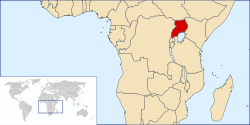This is an old revision of this page, as edited by Δ (talk | contribs) at 15:29, 17 June 2011 (All non-free files used on this page must have valid and specific rationale for use on this page; please see Misplaced Pages:Non-free use rationale guideline for more information; one or more file removed due to missing rationale). The present address (URL) is a permanent link to this revision, which may differ significantly from the current revision.
Revision as of 15:29, 17 June 2011 by Δ (talk | contribs) (All non-free files used on this page must have valid and specific rationale for use on this page; please see Misplaced Pages:Non-free use rationale guideline for more information; one or more file removed due to missing rationale)(diff) ← Previous revision | Latest revision (diff) | Newer revision → (diff)| It has been suggested that this article be merged into History of Uganda (1962–71). (Discuss) Proposed since March 2011. |
| Uganda | |||||||
|---|---|---|---|---|---|---|---|
| 1962–1963 | |||||||
 Flag
Flag | |||||||
| Motto: 'For God And My Country' | |||||||
| Anthem: 'Oh Uganda, Land Of Beauty'Royal anthem: God Save The Queen | |||||||
 Location of the commonwealth realm of Uganda(dark red) in Africa(light grey) Location of the commonwealth realm of Uganda(dark red) in Africa(light grey) | |||||||
| Status | Commonwealth Realm | ||||||
| Capital | Kampala | ||||||
| Official languages | English, Swahili | ||||||
| Government | Constitutional Monarchy | ||||||
| Queen of Uganda | |||||||
| • 1962-1963 | Elizabeth II | ||||||
| • 1962-1963 | Walter Coutts | ||||||
| Prime Minister | |||||||
| • 1962-1963 | Milton Obote | ||||||
| Historical era | Cold War | ||||||
| • Independence | 26 May 1962 | ||||||
| • Became 'State of Uganda' | 9 October 1963 | ||||||
| Currency | East African Shilling | ||||||
| ISO 3166 code | UG | ||||||
| |||||||
The commonwealth realm of Uganda, to give its official name, known simply as Uganda, was a predecessor to modern-day Uganda and an independent state that existed between 1962 and 1963. When British rule ended in 1962, Uganda was given independence as a commonwealth realm, in which the state existed until the proclamation of the state in 1963, The 'State of Uganda' came into existence on 9 October 1963. The description of the 'state' was implicitly implying that the post-commonwealth realm state was not a republic; given that it was a 'federation of tribal kingdoms'. Uganda did not de jure become a republic until 1966 and Milton Obote's conflict with President Edward Mutesa II (see below.) During the commonwealth realm phase, the British monarch remained head of state of Uganda, and was represented in Uganda by a governor-general. The following governor-general held office in Uganda during the commonwealth realm period:
- Sir Walter Coutts (9 October 1962 - 9 October 1963)
Milton Obote held office as prime minister (and head of government) of Uganda during this period.
Following the abolition of the Commonwealth Realm, the Kabaka (King) of Uganda, Edward Mutesa II became the first President of the new 'State of Uganda'.
See also
= References =
www.worldstatesmen.org/Uganda.html
www.archontology.org/nations/uganda/00_1962_1963_s.php
www.guide2womenleaders.com/Uganda.htm www.mapsofworld.com › Uganda › Government hansard.millbanksystems.com/lords/.../uganda-independence-bill
External links
www.worldstatesmen.org/Uganda.html
www.archontology.org/nations/uganda/00_1962_1963_s.php www.guide2womenleaders.com/Uganda.htm www.mapsofworld.com › Uganda › Government hansard.millbanksystems.com/lords/.../uganda-independence-billCategories: